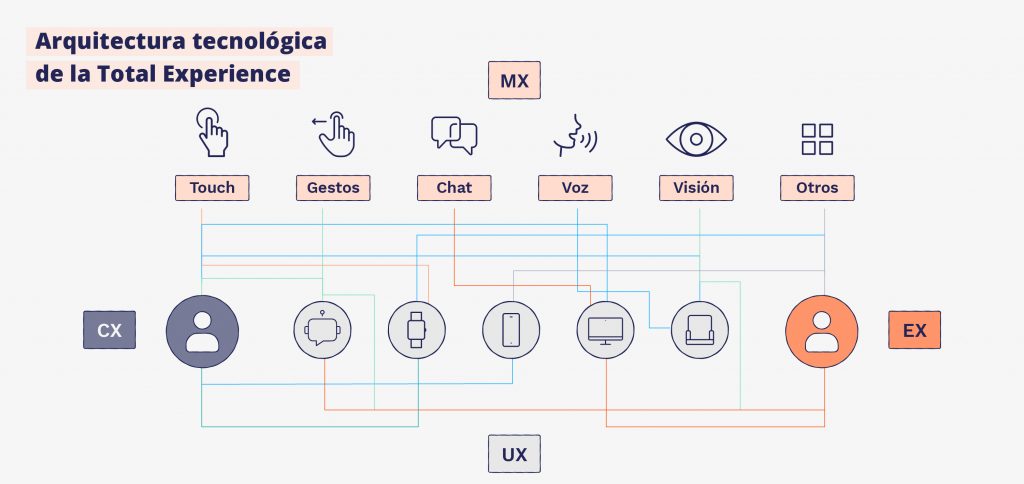Customer experience (CX) has been a growing priority for companies in the quest for greater customer satisfaction and retention.
But many companies make the same mistake: using a silo approach for customer experience, ignoring other experiences that also impact business results.
The concept of Total Experience(*) is a booming trends for companies in 2022. It’s an approach that calls for traditional CX to evolve, and is already promoted by the world’s leading brands to differentiate themselves from their competitors.
Projection
By 2026, 60% of large companies will use Total Experience to transform their business models and achieve high levels of customer and employee retention.

What is Total Experience?
Total Experience (TX) is a business strategy integrating several concepts to accelerate business growth:
-Customer Experience (CX)
-Employee Experience (EX)
-User Experience (UX)
-Multi Experience (MX)
By adopting a TX approach, experiences are managed holistically beyond the role the person occupies within the organization. TX helps to increase trust, satisfaction and retention not only for customers but for employees too.
This is achieved by interlinking the four core components: CX, EX, UX and MX.
Traditionally, these areas are worked separately, with teams dedicated to each despite knowing the interrelated impact they have on the other.
Take a simple example: an agent who is happy at work will provide better customer service and make an effort to bring a smile to the customer’s face.But when companies plan ways to improve CX and come up with the best touchpoints to streamline CX, EX isn’t always factored in. Meanwhile, UX and MX are often viewed as separate agendas , tied more to the technology than to the people who use them.
All these elements impact TX. The key is to view these experiences as a network composed of different “moments of truth”: points in the customer journey where a key event occurs and a brand opinion is formed. Times when your brand can shine and make stakeholders fall in love; or do the opposite and alienate or even lose them.
TX impact on each component of the experience
| Impact of the TX approach | ||
|---|---|---|
| Customer Experience (CX) | How the customer feels about the brand (and about themselves when they come into contact with the brand). This includes their expectations, needs, desires, beliefs and past experiences. | Increases engagement, providing self-management solutions but always has an on-call service representative. CX needs less friction and more enjoyment, through more communication options, better user interfaces and more empowered employees. |
| Employee Experience (EX) | How employees feel about their work: their level of satisfaction, day-to-day struggles and frustrations, and their perception of their own productivity and skills. | Employees are given the power to resolve situations on their own through faster, multi-channel tools. Employee satisfaction and retention is improved without increasing costs. According to Gartner, 79% of workers say that without digital technologies, they wouldn’t be able to do their jobs. It’s vital that these technologies are as simple to use as the ones they use outside of work. |
| User Experience (UX) | How the user relates to the products or services: usability, ease of use, and the perceived benefits of using the product or service. | Allows identification of friction points in the use of technologies. How long does it take the user to get a certain result? Are we providing flexible and adaptable technologies according to the context? The goal is to achieve a more intuitive and simpler UX across multiple devices. |
| Multiexperience (MX) | The experience around touchpoints, interfaces and devices. It’s the technological engine that brings all touchpoints together in one place. | The right platforms are configured for each person and technical architecture is created supporting employee and customer experience across multiple touchpoints and modalities (including gestures, voice, no-touch). |
When experiences aren’t integrated
Let’s look at an example of using the TX approach to elevate operational quality in a contact center that provides customer service:
A customer has trouble getting online during a holiday, and the contact center has one-third of the staff available. The only channel available for complaints is the telephone.
The person spends 40 minutes waiting to talk to someone, and every minute that goes by only increases the frustration and anger. These emotions have a negative impact on the agent, who must now devote energy to appeasing the customer while looking for a solution to the technical problem. This adds tof the work overload caused by the staff shortage during the holiday.
The agent has to transfer the complaint to the tech department, causing a longer wait time and increasing the customer’s frustration. Neither the customer nor the operator has an interface that lets them solve the problem quickly or better yet, self-manage it.
How do you achieve Total Experience?

Let’s do an exercise from a TX approach:
First, we need to address the MX, incorporating other interaction channels where the CX is more pleasant and fluid. For example, if you have the data on your cell phone, you could manage your complaint over Text, WhatsApp or WebChat with a bot that gives you directions to try to resolve it by yourself. If you still need instructions from an agent, the bot lets you know how long until an operator is available.
If the complaint is over the phone, self-service can be provided through IVR with an automated call back system (letting you know beforehand how long until they call you).
With this approach, we ensure from the get-go that the claim is entered and the customer senses a willingness to help, impacting the CX. The EX is affected at the same time when agents only receive previously filtered calls or interactions, because they already have all the information available on the case and they’re in charge of the interactions where they provide the most value.
This is achieved by leveraging UX to let agents and customers access self-service portals from multiple devices and work with technology to resolve steps on their own. By empowering EX and CX with technology and MX, we get to a state of TX.

An experience under constant development
How do you start incorporating TX into your company? Gartner recommends creating multidisciplinary teams in the company. One effective method is to continuously improve UX and MX capabilities, which will inevitably impact CX and EX.
Creating TX involves consolidating teams to also be “complete.” In other words, those in charge of experience-related initiatives are jointly responsible for solving the combined needs of customers and employees.
One thing experts point out is that TX is not a one-off strategy or the answer to a specific problem. Instead, it refers to a holistic approach that involves multiple departments within the company, plus partners and suppliers, to deliver the best experience to customers and employees.

Are you looking for ways to enhance your Total Experience? Let’s talk!



